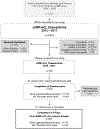Association of Traumatic Knee Injury With Radiographic Evidence of Knee Osteoarthritis in Military Officers
- PMID: 36530032
- PMCID: PMC11694904
- DOI: 10.1002/acr.25072
Association of Traumatic Knee Injury With Radiographic Evidence of Knee Osteoarthritis in Military Officers
Abstract
Objective: The association between knee injury and knee osteoarthritis (OA) is understudied relative to its importance, particularly in younger populations. This study was undertaken to examine the association of knee injury with radiographic features of knee OA in military officers, who have a physically demanding profession and high rates of knee injury.
Methods: Participants were recruited in 2015-2017 from an existing program that enrolled 6,452 military officers during 2004-2009. Officers with a history of knee ligament or meniscal injuries (n = 117 via medical record review) were compared to officers with no history of knee injury (n = 143). Bilateral posteroanterior knee radiographs were obtained using a standardized fixed-flexion positioning frame. All images were read for Kellgren/Lawrence (K/L) grade, osteophyte (OST), and joint space narrowing (JSN) scores. Data were analyzed using linear-risk regression models with generalized estimating equations.
Results: Injured and noninjured participants were similar (mean age 28 years, mean body mass index 25 kg/m2 , ~40% female). The mean time from first knee injury to imaging among injured participants was 9.2 years. Compared with noninjured knees, greater prevalence of radiographic OA (K/L grade ≥ 2), OST (grade ≥ 1), and JSN (grade ≥ 1) was observed among injured knees, with prevalence differences of +16% (95% confidence interval [95% CI] 10%, 22%), +29% (95% CI 20%, 38%), and + 17% (95% CI 10%, 24%), respectively. Approximately 1 in 6 officers with prior knee injury progressed to radiographic OA by age 30 years.
Conclusion: At the midpoint of a projected 20-year military career, officers with a history of traumatic knee injury have a markedly increased prevalence of knee radiographic OA compared to officers without injury.
© 2022 American College of Rheumatology.
Conflict of interest statement
Figures
References
-
- Lie MM, Risberg MA, Storheim K, Engebretsen L, Oiestad BE. What's the rate of knee osteoarthritis 10 years after anterior cruciate ligament injury? An updated systematic review. Br J Sports Med. 2019;53(18):1162–7. - PubMed
-
- Lohmander LS, Ostenberg A, Englund M, Roos H. High prevalence of knee osteoarthritis, pain, and functional limitations in female soccer players twelve years after anterior cruciate ligament injury. Arthritis Rheum. 2004;50(10):3145–52. - PubMed
-
- Grimm PD, Mauntel TC, Potter BK. Combat and Noncombat Musculoskeletal Injuries in the US Military. Sports Med Arthrosc Rev. 2019;27(3):84–91. - PubMed
-
- Moses B, Orchard J, Orchard J. Systematic review: Annual incidence of ACL injury and surgery in various populations. Res Sports Med. 2012;20(3-4):157–79. - PubMed
Publication types
MeSH terms
Grants and funding
LinkOut - more resources
Full Text Sources
Medical


